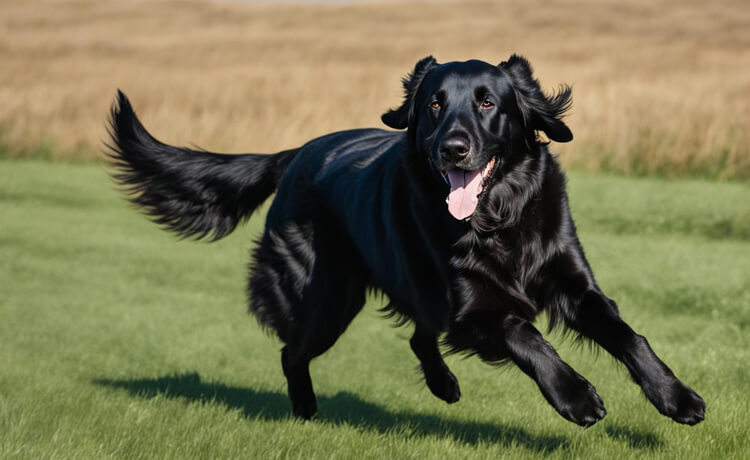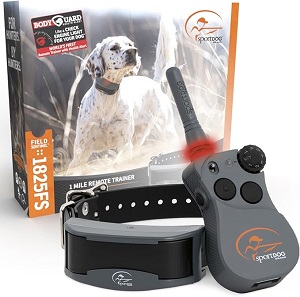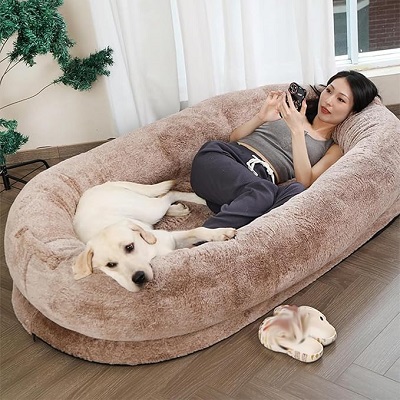
Flat-Coated Retriever
The Flat-Coated Retriever is an energetic, friendly, and highly sociable breed known for its beautiful coat, joyful personality, and love for water and outdoor activities. This breed excels as both a companion dog and a working retriever, making it an excellent choice for active families. Below is a detailed overview of the Flat-Coated Retriever.
Appearance:
The Flat-Coated Retriever is a medium to large-sized dog with a well-balanced, athletic build. The breed is distinguished by its long, glossy, flat-lying coat, which is typically black or liver (chocolate) in color. The coat is dense and water-resistant, providing the dog with the ability to work in wet and challenging conditions, especially as a retriever.
The head of the Flat-Coated Retriever is broad with a slight arch, and its expression is often described as “happy” and “enthusiastic.” The breed’s eyes are dark and almond-shaped, and it has a straight back, long tail, and strong, muscular legs that contribute to its ability to run and retrieve.
Temperament:
Essentials for Your Newly Adopted Pet
Welcoming a shelter pet into your life is a beautiful journey. Here are some handpicked items to help your new friend feel safe, loved, and right at home:
Known for its friendly and playful nature, the Flat-Coated Retriever is one of the most affectionate dog breeds. These dogs are particularly well-suited to families and tend to be excellent with children. They are also friendly toward strangers and other animals, which makes them great companions for households with multiple pets.
Flat-Coated Retrievers are extremely social dogs and do not like being left alone for long periods. They are also very intelligent and eager to please, making them easy to train. However, they can be somewhat boisterous, particularly as puppies, and may require consistent training and structure to develop into well-behaved adults.
Intelligence & Trainability:
Flat-Coated Retrievers are highly intelligent and trainable, excelling in obedience and dog sports. Their eagerness to please and high energy levels make them easy to work with in training sessions. They perform well in agility, obedience trials, fieldwork, and retrieving exercises.
However, while they are generally eager to learn, they also have a playful streak and can sometimes be distractible or overenthusiastic. Positive reinforcement methods, such as treats and praise, are highly effective with this breed. Because they are highly social, they also thrive when they are given tasks that involve interaction with their family members.
Exercise Needs:
As an active and energetic breed, the Flat-Coated Retriever has high exercise requirements. These dogs were originally bred to be waterfowl retrievers, which means they enjoy swimming and outdoor activities. They need regular exercise to keep them physically fit and mentally stimulated.
A daily walk, combined with playtime or other outdoor activities like swimming, running, or fetch, is essential for this breed. They thrive in households where they can engage in outdoor play and exploration. Without adequate physical and mental exercise, they may develop behavioral problems such as chewing, digging, or excessive barking.
Health:
Flat-Coated Retrievers are generally healthy dogs, but like many larger breeds, they can be prone to certain health issues. Some of the most common health concerns for the breed include:
- Hip dysplasia: A condition where the hip joint doesn’t develop properly, which can lead to arthritis.
- Elbow dysplasia: A similar condition that affects the elbow joints.
- Cancer: Flat-Coated Retrievers have a higher-than-average incidence of cancer, particularly hemangiosarcoma, a type of cancer affecting the blood vessels.
- Progressive retinal atrophy (PRA): A degenerative eye condition that can lead to blindness.
- Ear infections: Due to their floppy ears, they may be prone to ear infections if not cleaned and dried properly after swimming or bathing.
Routine veterinary care, a healthy diet, and regular exercise can help mitigate some of these risks.
History and Origin:
The Flat-Coated Retriever has a long history, originating in the 19th century in England. It was initially bred as a hunting dog, specifically designed for retrieving game from both land and water. The breed is believed to be a mix of the Labrador Retriever, the Newfoundland, and the Tweed Water Spaniel, along with other breeds.
Flat-Coated Retrievers were primarily used as retrievers for hunters, praised for their excellent water work and ability to fetch game from challenging environments. The breed was particularly popular during the late 19th and early 20th centuries, though it fell out of favor temporarily after World War II.
Today, the breed is recognized by major kennel clubs like the American Kennel Club (AKC) and the Kennel Club (UK), and it continues to be a popular choice for families, as well as an outstanding working dog in hunting and field trials.
Ideal Home:
The Flat-Coated Retriever is best suited for active families or individuals who have the time and space for regular exercise and play. They thrive in homes with a yard where they can run and play, though they can adapt to apartment living if given enough outdoor time.
Because they are highly social, they do not do well in homes where they are left alone for extended periods. They also need consistent training and structure to keep them well-behaved, especially when they are puppies. This breed is ideal for first-time dog owners who are ready for a playful and energetic companion.
Fun Facts:
- Flat-Coated Retrieversare sometimes called the “happy breed” because of their cheerful, positive, and enthusiastic personality.
- They are exceptional swimmers and love water-related activities such as swimming and playing in lakes or rivers.
- This breed excels in obedience and field trials, often being used as a working dog in hunting and retrieving events.
- Flat-Coated Retrievers are known for their long lifespan compared to other retriever breeds, with an average life expectancy of 10–12 years.
Conclusion:
The Flat-Coated Retriever is a joyful, friendly, and energetic breed that makes an excellent companion for active families or individuals. Whether you’re looking for a loving family pet or an energetic working dog, the Flat-Coated Retriever excels in both areas. Their cheerful nature, combined with their intelligence and trainability, makes them a wonderful choice for any household that can provide plenty of exercise, play, and love.
Affiliate Products
Up to 75% Discount

Dog Collar with Health Monitoring
BUY NOW »
Up to 55% Discount

Luxury Faux Furhuge Napping Bed
BUY NOW »

